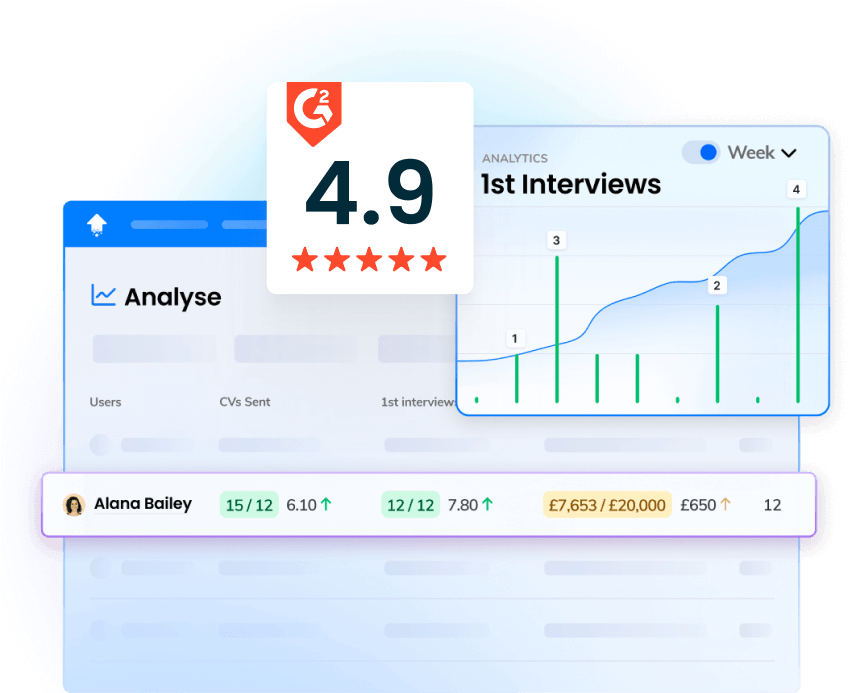A talent pipeline is a proactive recruitment strategy that puts relationship-building at the heart of your agency.
This more consultative approach to recruitment leads to an enhanced candidate experience and much happier clients.
As every recruiter knows, the recruitment landscape of 2024 is fiercely competitive.
But developing a talent pipeline puts you one step ahead of the competition, giving you a pre-screened pool of potential candidates ready to interview at a moment's notice.
What Is a Talent Pipeline?
A talent pipeline is a long-term, proactive recruitment strategy.
Using this approach, recruiters actively source and engage with potential candidates for future roles.
They then pre-screen — and sometimes pre-qualify — these candidates and build relationships with them through a nurturing process.
This gives recruiters a broad, high-quality future talent pool they can quickly draw from when a job is added.
Done well, the talent pipeline approach results in improved candidate quality, a significantly reduced time-to-hire, enhanced candidate experience, greater diversity in hiring, and a streamlined recruitment process.
The Core Components of a Talent Pipeline
So, what activities make up a talent pipeline?
Read on for a simple four-stage talent pipeline framework.
#1 Sourcing and attracting talent
Sourcing and attracting talent sits at the top of the talent pipeline.
This stage includes employer brand, creating ideal candidate profiles, building a database of passive candidates, posting on social media, developing content, writing job ads, posting to job boards, and tracking metrics.
This stage is about connecting with the right talent for your client base and building a robust candidate database for future roles.
#2 Engaging and nurturing candidates
Once you've found a strong potential candidate, you must engage them with your agency.
This may mean emailing, texting, calling, or direct messaging on platforms like LinkedIn — or simply replying to communication if the candidate has reached out to you.
At this stage, you need to sell your agency to them and emphasise how you can help them achieve their career goals.
It's also essential to find out vital information about the candidate, such as their current role and what they are looking for in terms of their next position.
Your approach to conveying this messaging should all be set out in your nurturing strategy.
Without an effective nurturing strategy, top-tier candidates could quickly lose interest in what your agency offers and slip through the net.
#3 Talent segmentation and categorisation
To be effective, your talent pipeline needs to be well-organised.
This is where talent segmentation and categorisation come into play.
The categories recruiters employ to segment candidates depend on the type of agency they work for and the specific needs of their clients.
However, common categories for candidate segmentation include:
- The sector/industry they work in
- Their current job role
- The candidate's seniority level
- The candidate's key skills and/or qualifications
Segmenting allows you to more effectively engage and nurture your candidates.
Say you hire into healthcare.
To keep your candidates engaged and effectively nurture your talent pool, post relevant content on social media channels and send mass emails containing the latest jobs.
However, content designed for paramedics may not be relevant to chiropractors, for example. Similarly, weekly round-ups of GP jobs will be of little interest to professionals seeking pharmaceutical roles.
Sure, you could just send all your content and roles to all your candidates — and for many years, this was the approach of most agencies.
But in 2024, professionals expect a more tailored service — and recruiters now have the technology to deliver it.
By segmenting your candidate lists, you can ensure that each candidate only receives the content that is most relevant to them.
This is much more likely to keep them engaged with your agency — and to help them feel valued.
It makes the recruiter's job easier, too.
For example, if you have already segmented your talent by job role, it's much quicker to find top candidates for a dental nurse role than if you had to dig through your entire database of healthcare professionals.
#4 Continuous communication and relationship-building
Once you've connected with potential candidates and added them to your pipeline, you must ensure they remain engaged with your agency.
After all, the right job for a candidate may not come up for months or even years.
And you need to keep them on board.
This is all about relationship building.
Recruiters should regularly communicate with candidates within the pipeline and check in to see if their job status has changed.
Tactics range from mass communication, such as social media posting, advertising, and mass emails, to personal communication, like direct emails, LinkedIn messages, and phone calls.
Benefits of Implementing a Talent Pipeline
There are so many benefits to taking a modern, proactive talent pipeline approach to recruitment.
Here are five of the biggest:
#1 Reduced time-to-hire
With a pipeline of pre-vetted candidates ready to be placed, time-to-hire is significantly reduced.
This leads to happier clients and more commission for your agency.
#2 Improved quality of candidates
After you implement a recruitment pipeline, you should find that the quality of candidates you're sending to interviews significantly increases.
Why?
When a job is added, you'll already have a long list of candidates perfect for the role, and you'll have their contact information, too.
This means no more submitting sub-par candidates just to make up the numbers or reaching out to potential candidates only to be ignored.
It allows for much more thoughtful, methodical recruitment, ensuring you only deliver top talent.
#3 Enhanced candidate experience
Talent pipeline strategies typically deliver a more consultative approach to recruitment than traditional reactive tactics.
Pipeline recruiters focus on relationship building, arming candidates with the knowledge they need to succeed, and supporting them in achieving their career goals.
And as the talent pipeline approach empowers recruiters to only submit candidates they truly believe are a great match, candidates no longer waste time on jobs they're unlikely to secure or thrive in.
#4 Greater diversity in hiring
With a reactive hiring process, recruiters simply put out a job ad, wait for the CVs to roll in, and then select from their options.
However, implementing a talent pipeline approach allows recruiters to actively seek candidates from a wide variety of backgrounds, cultures, and experiences, vastly increasing the quality of their talent pool.
This may include partnerships with schools, colleges, and universities and attending a wide range of online and in-person events.
Building a diverse talent pipeline has many benefits, from increasing the quality of candidates and delivering better fits to clients to having a wider talent pool to pick from.
#5 Streamlined recruitment process
A talent pipeline streamlines the recruitment process so recruiters, clients, and candidates all see results faster.
And there's much less friction along the way.
With the talent pipeline approach, candidates are pre-vetted and often pre-qualified before an appropriate role arises.
In some cases, recruiters will also conduct background checks and skills assessments.
Once a relevant job is added, it is simply a case of reaching out to candidates, sending CVs to the hiring manager, and then sending candidates for interviews.
How to Build a Strong Talent Pipeline
So, how to build a talent pipeline?
Step 1 - Identify key roles and skills
Start by crafting ideal candidate profiles around the key roles your agency frequently hires into.
This is key to building a talent pipeline.
After all, without a job description to direct you, you need to give direction to sourcing activities.
These ideal candidate profiles should include the skills, experience, and qualifications required for these roles.
Step 2 - Develop a sourcing strategy
With a talent pipeline, sourcing happens earlier in the recruitment process — and it's even more instrumental to success.
Develop your sourcing strategy based on your clients' needs and the type of candidates you need to attract.
This should take into account the online and offline channels through which you intend to source candidates, as well as how you will communicate with potential candidates.
Your sourcing strategy's results should be consistently tracked and analysed, allowing you to continuously hone it and enhance its effectiveness.
Step 3 - Leverage technology and automation
In 2024, technology and automation can supercharge your recruitment strategy.

Consider your agency's specific needs and pain points surrounding your talent pipeline, and what technology could address these.
Take a look at:
- Recruitment management systems (RMS)
- Candidate relationship management systems (CRM)
- Applicant tracking systems (ATS)
- Recruitment performance management software
- Data analytics tools
- Sourcing and outreach tools
Remember, automation speeds up and smoothens the recruitment journey, and can help you build a stronger talent pipeline, faster.
Automation use cases within the talent pipeline include sourcing and outreach, skills matching, candidate communication, and data analytics.
When investing in new recruitment tech, ensure it has built-in automation capabilities.
Step 4 - Build and maintain relationships with candidates
A focus on building and maintaining relationships with candidates is at the heart of any good talent pipeline strategy.
Once you've outlined your strategy and invested in the technology that will empower you to bring your talent pipeline to life, it's time to get out there and do the work.
Step 5 - Use OneUp for data and analytics for pipeline management
Recruiting analytics software OneUp delivers a user-friendly interface and beautiful visualisations that allow you to understand your pipeline in real-time.
With OneUp, you can track all your pipeline data from across your systems in one place and set up custom reporting dashboards tailored to your metrics.
This is invaluable when measuring the effectiveness of your pipeline and making data-driven decisions to improve its performance.
Best Practices for Talent Pipeline Management
When it comes to talent pipeline development, there are five vital best practices to follow.
These are:
- Regularly update and review the pipeline
- Ensure consistent communication with candidates
- Integrate with other recruitment tools and systems
- Focus on diversity and inclusion
- Measure and analyse pipeline performance
OneUp's Role in Enhancing Your Talent Pipeline
Recruiting analytics software OneUp can help to ensure your talent pipeline works the way you want and need it to.

Its reporting suite empowers you to track and analyse the pipeline metrics that are important to you with custom dashboards and intuitive visualisations. Meanwhile, automated reports take the time and effort out of data analytics.
OneUp pulls real-time data from across your systems, allowing you to gain an overview of precisely what is happening in your talent pipeline, when it's happening.
Recruiters can then drill down into these analytics to discover which activities contributed to pipeline successes or failures and use this information to continually improve their approach.
Furthermore, recruitment leaders can easily set and track targets for recruiters and teams, enabling high-performance data-driven recruitment.
OneUp integrates with a wide range of existing RMSs and CRMs, VoIP tools, timesheets, and social media.
Why Invest in a Talent Pipeline?
A talent pipeline drives down your time-to-hire, boosts candidate quality, enhances the candidate experience, leads to greater diversity in hiring, and streamlines your recruitment process.
In the uber-competitive recruiting landscape of 2024, reactive recruitment often doesn't cut it any more.
Instead, get ahead of the competition with a proactive talent pipeline strategy that arms you with a high-quality talent pool you can deploy whenever you need to.
Ensure you supercharge your progressive talent pipeline strategy with cutting-edge recruitment analytics tools like OneUp. This intuitive platform will empower you to continually improve your processes, saving your recruiters time and boosting the bottom line.
To find out more about how OneUp can boost your talent pipeline, book your demo here today.




